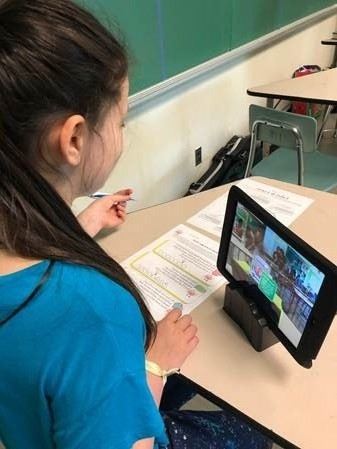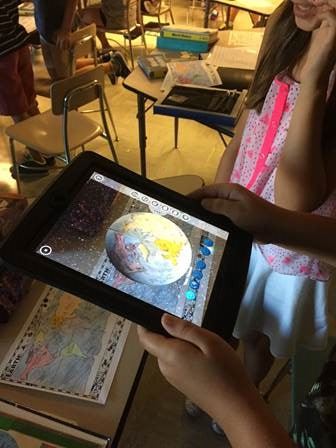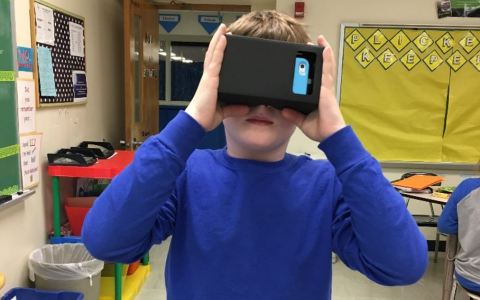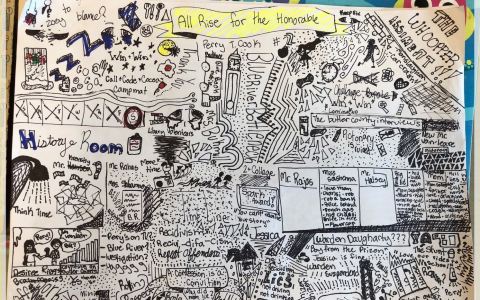Grand Island Central School District - Student Engagement: An Open and Shut Case
Mary Howard, a 6th grade teacher from Grand Island, New York and finalist for the 2018 NYS Teacher of the Year, has found success in narrative and reward-based learning through crime scenes, escape rooms, scavenger hunts, 360 experiences, and more. She utilizes prevalent activities in pop-culture and transitions them into the classroom, and incorporates technology such as Virtual Reality, 3D Design, QR codes and circuits in order to add an additional layer of interest from her students. Her engagement strategies not only make learning fun for her students, they encourage critical thinking, collaboration, and create a life-long passion for learning.
Using Green Screens to write book review summaries, modeling mummies from Ancient Egypt with hotdogs, and learning vocabulary by playing the game Jenga are not traditional practices of learning. For a middle school teacher in upstate New York, these activities are normal parts of the school day. Mary Howard’s success with her students lies in her perspective of learning as an adventure. About ten years ago, she introduced blogging to her students by assigning them to create WikiSpaces. Shortly after, she realized that “there is something really magical about giving students choice and control and using technology to drive the instruction,” Howard said.
According to Howard, it is crucial for students to develop a resilience for struggle:
"In inquiry-based learning, there is going to be struggle, and students need to know that it is okay. It is important to provide students the space to tolerate ambiguity and for them to understand that it is okay to not always be right. There is not always one right answer and there will often be a struggle to achieve a solution."
Once a student is engaged, there is space for inquiry, critical thinking, and cooperative learning. However, to succeed at this style of teaching, a collaborative classroom norm must first be established. Howard emphasizes the importance of establishing a classroom norm and a culture of collaborative learning and struggle.
One of her favorite activities are Escape Rooms, a popular form of entertainment where a group of people enter a room and must break themselves out by solving a series of clues, riddles, and puzzles. Players must solve the riddle within a certain amount of time to “win.” Howard replicates this activity in the classroom and uses the information her students are currently learning in the form of riddles. “Because we can’t lock children inside of a room [like a typical escape room], we have them break into something,” Howard says. She loves Escape Rooms because of their reach: “You see students come out of the woodwork that you never would have seen coming. Suddenly, the student who has developmental issues and has never really spoken a word is the leader in the room, and everyone is asking him or her how they did that.” Howard believes students should be the leaders while the teacher acts as the facilitator. “The teacher isn’t supposed to be the one working the hardest,” says Howard. “The kids are!”
All of her engagement activities require an understanding that collaborative games are what interests middle school students the most. “I realized that I have to do what I can to engage them. I don’t want to lose them. I want them to love school, and some middle schoolers really hate school.” To avoid these negative feelings from her students, Howard asked herself, “What drives a middle schooler?” The answer she came up with was cooperative, collaborative learning, working with peers, and being out of their seats and moving. Howard said, “Middle school is a difficult time developmentally for students. It’s a very difficult time in their lives, and many of them become disinterested in school very quickly. You have to capture them, because if you lose them, they’re gone.”
Howard realizes the importance of meeting students where they are, rather than expecting them to meet her where she is. “I need to be able to provide experiences that reach where they are coming from.” She admits her drive to embed engagement strategies into her teaching also stems from being “a technology person,” and was fueled through her work with NYSCATE for the past decade. Howard said, “It is about the engagement strategies, but for me, it’s really about the technology. The two go hand in hand: the technology drives the ideas as fantastic opportunities to keep students engaged and interested.”
Since Howard’s district is not one to one, she faces some struggles in the classroom. When she wants iPads or Chromebooks for an activity, she must reserve a cart. When she wants to engage in digital initiatives, like Google Cardboard or using Augmented Reality, she asked students with smartphones to load the apps onto their own personal devices. In her experience, around 60-70% of sixth graders have personal devices. To work around accessibility issues, Howard encourages those students to be group leaders so that every group of students have at least one device.
The common themes present in each of her strategies are a storyline, an objective, and a goal, whether she is conducting an escape room, crime scene or a scavenger hunt. Each activity is always standards-driven and narrative based. Howard “capitalizes on the fascinations” of her students by keeping up with current trends, targeting what is popular with the younger generation to interest them. Students were provided the opportunity to create any object they desired with a Merge Cube, a device that works in association with a smartphone to create three-dimensional (3D) models. Students had to explain why the models came out different than they had imagined, without using the word “because” in their explanations.
Howard used Virtual Reality to help students learn to write in first-person from the perspective of a droid: students used a mouse to explore a 360° video of a Star Wars world and documented what they saw. When her students were learning about archeology, she used 3D models of fossils and had her students take field notes to understand the differences between early hominid fossils. After they analyzed the models, they ranked the fossils from the oldest to the most recent and supported their choices with evidence. Through these activities, students reinforce concepts they have already learned, and even learn new concepts.
Howard summarize's New York’s 2017 Teacher of the Year, Amy Hysick, for her breakdown of the neuroscience behind fun in learning (2017):
"The endorphins that are produced as a result of positive experiences allow them to be more receptive to learning. In addition, those endorphins are addictive. The body remembers the positive and safe feelings that are associated with the environment and will produce those endorphins each time the student is in the environment. This means that you'll have created a situation where the student's physiology will be biochemically altered to perceive your classroom as a safe place for risk-taking that is necessary for learning."
Howard believes that activities, even as small as allowing her students to choose their own fake names or using duct tape to create light saber pencils, contribute toward “setting the stage for learning.” She uses memes as a supplemental form of grading to personalize digital feedback, uses apps to craft secret messages, and creates matching games with flashcards to learn vocabulary. Howard believes that it is the small details that make the experience: “If you’re theatrical, it helps. It’s so much different than giving students a packet. Any little thing you add makes such a difference.” For Escape Rooms, Howard uses yellow caution tape, badges, and even an outline of a body on the floor. Escape Room kits for the classroom can be purchased online, but Howard usually designs her own kits. Howard even adds an engaging component to taking notes. Sketchnoting is a spin on traditional note-taking. Howard defines it as purposeful doodling on paper while listening to something. It helps students make connections to text, as well as visualize and summarize the information they are hearing. The strategies and activities Howard use are more than just a way to engage students; they are a way to encourage a life-long passion for learning.
Howard sees educational technology as the bridge that balances entertaining and learning. The technology captures their imagination: “it’s entertaining, but it’s also inspirational.” Howard has found that technology provides students who simply want to do something the drive to ask how they can do something. Like most things, it’s important to have a balance; Howard agrees that “too much of anything loses its novelty and excitement.” To avoid this, Howard uses one unique and novel digital experience, along with a collaborative element, in every unit. She also includes a competitive element in each activity to motivate her students. One unit is “gamified,” where students earn badges instead of grades. She showcases the badges in the classroom and rewards the first two students who figure out the riddle. “They won’t just do a little; they’ll do a lot to get that reward. It brings a different dynamic to the room,” Howard said.
And it works. Her student’s test results are always on par or above her counterparts. However, she is quick to add that standardized testing is not evidence of student/teacher achievement. Every class is unique, and she said that it’s nearly impossible to measure or compare teacher success from test scores. Creativity and the pursuit of knowledge is her personal goal with her students. “I want students to question the world around them and gather information as they see fit. I want them to be inquisitive, creative and tolerate ambiguity in novel situations. If they leave my classroom with those skills, then I’ll know that I have been successful,” she said. Howard has physical evidence to back up her success outside of the classroom: at the 2018 International Society for Technology in Education (ITSE) conference in Chicago, she won the “Virtual Pioneer of the Year Award.” Howard is ambitious, daring, innovative, and motivated. And most importantly, she is excited about learning. Learning doesn’t have to be a tedious, monotonous task. We can all learn from Mary Howard that a little effort and creativity can go a long way.
Contact
- Mary Howard, Sixth Grade Teacher, Grand Island Central School District, maryhoward@gicsd.org, Twitter: @mrshoward118
Author
- Karlie Flood, Intern, Department of Educational Design and Technology, New York State Education Department, Karlie.Flood@nysed.gov
References
- Howard, Mary. Using Your Smarticles, 2018.
- Hysick, Amy. “How Your Classroom Fashion Can Foster a More Effective Learning Space.” Discovery Education, 2017.









